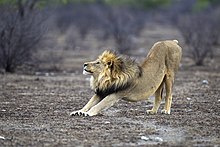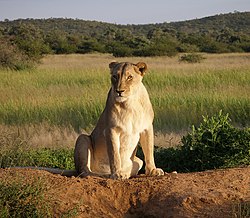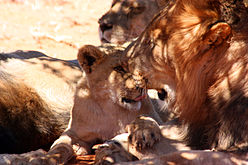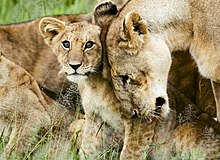Lion
History
The Lion (Panthera leo) is one of the big cats in the genus Panthera and a member of the family Felidae. The commonly used term African lion collectively denotes the several subspecies found in Africa. With some males exceeding 250 kg (550 lb) in weight, it is the second-largest living cat after the tiger. Wild lions currently exist in sub-Saharan Africa and in India (where an endangered remnant population resides in Gir Forest National Park). In ancient historic times, their range was in most of Africa, including North Africa, and across Eurasia from Greece and southeastern Europe to India. In the late Pleistocene, about 10,000 years ago, the lion was the most widespread large land mammal after humans: Panthera leo spelaea lived in northern and western Europe and Panthera leo atrox lived in the Americas from the Yukon to Peru. The lion is classified as a vulnerable species by the IUCN, having seen a major population decline in its African range of 30–50% per two decades during the second half of the twentieth century. Lion populations are untenable outside designated reserves and national parks. Although the cause of the decline is not fully understood, habitat loss and conflicts with humans are the greatest causes of concern. Within Africa, the West African lion population is particularly endangered.In the wild, males seldom live longer than 10 to 14 years, as injuries sustained from continual fighting with rival males greatly reduce their longevity. In captivity they can live more than 20 years. They typically inhabit savanna and grassland, although they may take to bush and forest. Lions are unusually social compared to other cats. A pride of lions consists of related females and offspring and a small number of adult males. Groups of female lions typically hunt together, preying mostly on large ungulates. Lions are apex and keystone predators, although they are also expert scavengers obtaining over 50 percent of their food by scavenging as opportunity allows. While lions do not typically hunt humans, some have. Sleeping mainly during the day, lions are active primarily at night (nocturnal), although sometimes at twilight (crepuscular).
Highly distinctive, the male lion is easily recognised by its mane, and its face is one of the most widely recognised animal symbols in human culture. Depictions have existed from the Upper Paleolithic period, with carvings and paintings from the Lascaux and Chauvet Caves in France dated to 17,000 years ago, through virtually all ancient and medieval cultures where they once occurred. It has been extensively depicted in sculptures, in paintings, on national flags, and in contemporary films and literature. Lions have been kept in menageries since the time of the Roman Empire, and have been a key species sought for exhibition in zoos over the world since the late eighteenth century. Zoos are cooperating worldwide in breeding programs for the endangered Asiatic subspecies
Behaviour
Adult male lion stretching.
Hunting and diet
Lion teeth are typical of a carnivore.
Lions eat heron
The lionesses do most of the hunting for the pride. The male lion associated with the pride usually stays and watches over young cubs until the lionesses return from the hunt. Typically, several work together and encircle the herd from different points. Once they have closed in on the herd, they usually target the animal closest to them. The attack is short and powerful; they attempt to catch the victim with a fast rush and final leap. The prey usually is killed by strangulation, which can cause cerebral ischemia or asphyxia (which results in hypoxemic, or "general", hypoxia). The prey also may be killed by the lion enclosing the animal's mouth and nostrils in its jaws (which would also result in asphyxia).
Lions usually hunt in coordinated groups and stalk their chosen prey. However, they are not particularly known for their stamina – for instance, a lioness' heart makes up only 0.57% of her body weight (a male's is about 0.45% of his body weight), whereas a hyena's heart is close to 1% of its body weight. Thus, they only run fast in short bursts,and need to be close to their prey before starting the attack. They take advantage of factors that reduce visibility; many kills take place near some form of cover or at night. They sneak up to the victim until they reach a distance of approximately 30 metres (98 feet) or less.
Lioness in a burst of speed while hunting.
Extensive studies show that lionesses normally prey on mammals with an average weight of 126 kg (278 lb), while kills made by male lions average 399 kg (880 lb). In Africa, wildebeest rank at the top of preferred prey (making nearly half of the lion prey in the Serengeti) followed by zebra. Lions do not prey on fully grown adult elephants; most adult hippopotamuses, rhinoceroses, and smaller gazelles, impala, and other agile antelopes are generally excluded. However, giraffes and buffaloes are often taken in certain regions. For instance, in Kruger National Park, giraffes are regularly hunted. In Manyara Park, Cape buffaloes constitute as much as 62% of the lion's diet, due to the high number density of buffaloes. Occasionally hippopotamus is also taken, but adult rhinoceroses are generally avoided. Warthogs are often taken depending on availability.The lions of Savuti, Botswana, have adapted to hunting young elephants during the dry season, and a pride of 30 lions has been recorded killing individuals between the ages of four and eleven years.In the Kalahari desert in South Africa, black-maned lions may chase baboons up a tree, wait patiently, then attack them when they try to escape:
Baboons trapped up a tree by lions.
Four lionesses catch a cape buffalo.
Male lion.
Female Lion
Distribution of lions in India: The Gir Forest, in Gujarat, is the last natural range of more than 500 wild Asiatic lions. There are plans to reintroduce some lions to Kuno Wildlife Sanctuary in neighbouring Madhya Pradesh.
Lion Video .
Mating lion
A pregnant lioness
A tolerant black-maned male
Health
Although adult lions have no natural predators, evidence suggests that the majority die violently from humans or other lions. Lions often inflict serious injuries on each other, either members of different prides encountering each other in territorial disputes, or members of the same pride fighting at a kill.Crippled lions and lion cubs may fall victim to hyenas, leopards, or be trampled by buffalo or elephants, and careless lions may be maimed when hunting prey.
Lions seeking refuge from flies by climbing a tree.
Communication
Head rubbing and licking are common social behaviours within a pride
 |
| A lion depicted on a decorative panel from Darius I the Great's palace of the Persian Empire (550–330 BC). |















No comments:
Post a Comment